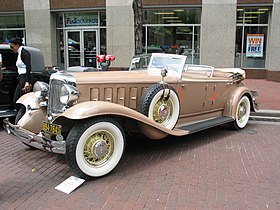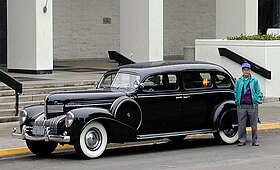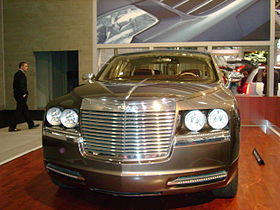Chrysler Imperial
| Chrysler Imperial | |
|---|---|
 |
|
| Overview | |
| Manufacturer | Chrysler |
| Production | 1926–1954 1980–1983 1990–1993 |
| Body and chassis | |
| Class | Full-size luxury car |
| First Generation | |
|---|---|
 |
|
| Overview | |
| Production | 1926–1930 |
| Body and chassis | |
| Body style | 2-door roadster 2-door coupe 4-door sedan and phaeton Limousine |
| Layout | FR layout |
| Powertrain | |
| Engine | 288.6 cu in (4.7 L) (1926–1927)309.3 cu in (5.1 L) (1928–1930) L-head 92 hp(1926–1927) 100 hp(1928), 110 hp(1929–1930)I6 |
| Transmission | 3-speed manual 4-speed manual |
| Dimensions | |
| Wheelbase | 120 in (3,048 mm) 136 in (3,454 mm) 127 in (3,226 mm) 133 in (3,378 mm) |
| Length | 183.5"(1926–1927) |
| Second Generation | |
|---|---|
 |
|
| Overview | |
| Production | 1931–1933 |
| Body and chassis | |
| Body style | 2-door roadster 2-door coupe 4-door sedan 4-door limousine |
| Layout | FR layout |
| Related |
DeSoto Series K-SA Dodge Eight |
| Powertrain | |
| Engine | 384.84 cu in (6.3 L) L-head 125 hp(1932) 135 hp(1933)I8 |
| Transmission | Multi-range 4-speed manual |
| Dimensions | |
| Wheelbase | 124"(1931); Imperial 126", Custom Imperial 146"(1933) |
| Length | Custom Imperial 212.5"(1932) |
| Third Generation | |
|---|---|
 |
|
| Overview | |
| Production | 1934–1936 |
| Body and chassis | |
| Body style | 4-door sedan |
| Layout | FR layout |
| Related |
Chrysler Airflow Chrysler Airstream DeSoto Airflow DeSoto Airstream |
| Powertrain | |
| Engine | Imperial Airflow and Imperial Airflow Custom CX-323.5CID cast-iron L-head 130 hp 250lb.ft.torque Straight-8 (1934–1936); Imperial Airflow Custom CW-384.8CID cast iron L-head 150 hp CR 6.5:1 Strait-8 (1934–1936) |
| Transmission | Imperial Airflow and Imperial Airflow Custom CX:3-speed manual floor-shift; Imperial Airflow Custom CW:4-speed manual, overdrive in 1935–1936 |
| Dimensions | |
| Wheelbase |
|
| Fourth Generation | |
|---|---|
 |
|
| Overview | |
| Production | 1937–1939 |
| Body and chassis | |
| Body style | 4-door, 7-seater limousine |
| Layout | FR layout |
| Related |
Chrysler Saratoga Chrysler Royal |
| Powertrain | |
| Engine | 323.5 cu in (5.3 L) Chrysler Flathead engine 130 hp (1937) 140 hp(1941–1942) |
| Transmission | 3-speed synchromesh manual Fluid Drive |
| Dimensions | |
| Wheelbase | 144 in (3,658 mm) |
| Length | 1937 204.75" (Imperial), 223.25"(custom Imperial) |
| Curb weight | 3,450-3,835lbs.(1938) |
| Fifth Generation | |
|---|---|
| Overview | |
| Production | 1940–1948 |
| Body and chassis | |
| Body style | 4-door sedan 4-door limousine |
| Layout | FR layout |
| Related |
Chrysler Saratoga Chrysler New Yorker Chrysler Windsor |
| Powertrain | |
| Engine | 323.5CID L-head 135 hp I8 |
| Transmission | Fluid Drive |
| Dimensions | |
| Wheelbase | 145.5" |
| Length |
1940 225.25" |
| Width | 77.8" |
| Curb weight | 3,900-4,560lbs.(1941) |
| Sixth Generation | |
|---|---|
 |
|
| Overview | |
| Model years | 1949–1954 |
| Assembly | Detroit, Michigan, United States |
| Designer | K.T. Keller |
| Body and chassis | |
| Body style | 2-door Club coupe 2-door hardtop 2-door Newport hardtop 2-door convertible 4-door sedan 4-door Imperial Custom limousine 4-door Imperial Crown sedan 4-door Imperial Crown limousine |
| Layout | FR layout |
| Related |
Chrysler Imperial Parade Phaeton Chrysler New Yorker Chrysler Town and Country Chrysler Saratoga DeSoto Custom |
| Powertrain | |
| Engine | 324 cu in (5.3 L) Chrysler I8 331 cu in (5.4 L) Hemihead V8 |
| Transmission | 4-speed Presto-Matic semiautomatic 2-speed PowerFlite automatic |
| Dimensions | |
| Wheelbase | 131.5 in (3,340 mm) 1953–54 4-door: 133.5 in (3,391 mm) Imperial Crown : 144.5 in (3,670 mm) |
| Length | Imperial and Imperial Custom: 1949: 210.0 in (5,334 mm) 1950: 214.0 in (5,436 mm) 1951: 212.5 in (5,398 mm) 1952: 212.6 in (5,400 mm) 1953 4-door: 219.0 in (5,563 mm) 1953 2-door: 217.0 in (5,512 mm) 1954 4-door: 223.8 in (5,685 mm) 1954 2-door: 221.8 in (5,634 mm) Imperial Crown : 1949: 234.8 in (5,964 mm) 1950: 230.3 in (5,850 mm) 1951–52: 229.5 in (5,829 mm) 1953: 231.6 in (5,883 mm) 1954: 236.4 in (6,005 mm) |
| Width | Imperial and Imperial Custom: 1949–52: 75.8 in (1,925 mm) 1953: 76.8 in (1,951 mm) 1954: 77.8 in (1,976 mm) Imperial Crown: 1949–52: 80.9 in (2,055 mm) 1953: 81.9 in (2,080 mm) 1954: 82.9 in (2,106 mm) |
| Height | 4-door: 63.0 in (1,600 mm) 2-door: 64.4 in (1,636 mm) Imperial Crown: 68.8 in (1,748 mm) |
| Curb weight | 4,400–5,700 lb (2,000–2,600 kg) |
| Chronology | |
| Successor | Imperial |
| Seventh Generation | |
|---|---|
 |
|
| Overview | |
| Production | 1989–1993 |
| Model years | 1990–1993 |
| Assembly | Belvidere, Illinois |
| Body and chassis | |
| Body style | 4-door sedan |
| Layout | FF layout |
| Platform | Y-body |
| Related | Chrysler New Yorker Fifth Avenue |
| Powertrain | |
| Engine | 3.3 L EGA V6 3.8 L EGH V6 |
| Transmission | 4-speed automatic |
| Dimensions | |
| Wheelbase | 109.6 in (2,784 mm) |
| Length | 203 in (5,156 mm) |
| Width | 68.9 in (1,750 mm) |
| Height | 55.3 in (1,405 mm) |
| Curb weight | 3,519 lb (1,596 kg) |
| Chronology | |
| Successor | Chrysler LHS |
| Chrysler Imperial Concept | |
|---|---|
 |
|
| Overview | |
| Production | 2006 (Concept car) |
| Body and chassis | |
| Class | Full-size luxury car |
| Body style | 4-door sedan |
| Layout | FR layout |
| Platform | Chrysler LY platform |
| Related | Chrysler 300 |
| Dimensions | |
| Wheelbase | 123-inch (3,124 mm) |
The Chrysler Imperial, introduced in 1926, was Chrysler's top of the line vehicle for much of its history. Models were produced with the Chrysler name until 1954, and again from 1990 to 1993. The company positioned the cars as a prestige marque to rival Cadillac, Lincoln, and Packard. According to a feature article in AACA's magazine The adjective ‘imperial’ according to Webster’s Dictionary means sovereign, supreme, superior or of unusual size or excellence. The word imperial thus justly befits Chrysler’s highest priced quality model.
In 1926, Walter P. Chrysler decided to compete with North American marques Cadillac, Lincoln, Packard, and Duesenberg in the luxury car field.Chrysler offered a variety of body styles: a two/four-passenger roadster (four passenger if car had the rumble seat), a four-seat coupé, five-passenger sedan and phaeton, and a seven-passenger top-of-the-line limousine. The limo had a glass partition between the front and rear passenger compartments.
The Imperial's new engine was slightly larger than the company's standard straight 6. It was a 288.6 cu in (4.7 L) six-cylinder with seven bearing blocks and pressure lubrication of 92 brake horsepower (69 kW). Springs were semi-elliptic in the front. The car set a transcontinental speed record in the year it was introduced, driving more than 6,500 miles (10,460 km) in the week. The car was chosen as the pace car for the 1926 Indianapolis 500. The model was designated E-80, the 80 being after the "guaranteed" 80 miles per hour (129 km/h) all-day cruising speed. Acceleration was also brisk breaking 20 seconds to 60 miles per hour (97 km/h). Four-speed transmission was added in 1930. The attention to luxury and multiple bodystyles was a similar approach used by Mr. Chrysler's time as President of the Buick Motor Company, his previous employer from 1911-1919.
...
Wikipedia
